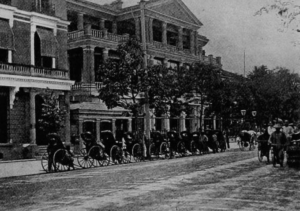Established by the British settler population in Shanghai in 1873 in the prestigious location of the Shanghai Bund, the Shanghai Club was reported to be the ‘microcosm par excellence of the Settlement.’1 The Club’s membership was the most exclusive in Shanghai and the club was indisputably the space that British male society revolved around. This blog post will use articles from the North China Herald to explore how the Club demonstrated how populations of foreign settlements imported their social hierarchies into Shanghai via their own social spaces. Further, it will also comment on the role of newspapers as historical sources.
The opening of the new building of the Shanghai Club was reported in the North-China Herald on January 7th 1911 as ‘something more than a landmark in the history of a social institution’ .2 as commented in the same article that ‘the founding members of the Shanghai Club had in their mind that it should resemble a segment cut from the home circle’.2 The ‘frontage is certainly the most imposing on the Bund’3 and the ‘design throughout is a rendering of the English renaissance’2 this description of the club highlights the importance and prestige of the Club within the settler population. It further illustrates how the social characteristics of London clubs were transplanted to Shanghai. This desire for the club to resemble ‘the home circle’ stems from as Robert Bicker argues the fear in treaty ports that ‘a community which had compromised its ‘Britishness’ would lose government support.’4 The exterior of the building was a ‘rendering of the English renaissance’ illustrating how the club was designed to be a physical representation of the might of the British Empire and was ‘the most imposing’ in an attempt to intimidate the other surrounding buildings. The Club was used and publicised to transplant the British cultural values as H R Panckridge remarked, ‘for more than a century no institution has been more peculiarly British than a social club’.5 is desire to make the club a symbol of Britishness abroad was also evidenced through how the Shanghai Club unlike the French or American clubs chose to preserve their British exclusivity throughout its existence.6 This specific boundary, through membership rules, between British interaction with other communities and individuals portrays how the club not only aimed to reinforce social hierarchies with the local Chinese population but, also was seen as a space which could be used to cement and perpetuate British political and economic power toward other Western powers.
Newspapers are invaluable sources through which historians can gain a sense of popular opinion and perceptions, the North-China Herald is an excellent English language source for the British settler population in Shanghai. However, due to the commercial motives of newspapers one has to note they can often have political or propagandist agendas leading them to embellish their descriptions and present events in an artificial light. From Bickers’ argument, it is clear that the settler population wanted to be portrayed in a manner that embodied the British imperial characteristics of prestige, strength and exclusivity. The North-China Herald, would have been able to be accessible back in England and was accessible for visiting English dignitaries thus it was an excellent way for the settler population to illustrate their Britishness abroad so they could continue to secure governmental support. This consideration must be included when using these newspaper sources to further investigate the club.

The Shanghai Club, Photo by C.E, Darwent. Taken from: Darwent, C.E, Shanghai: a handbook for travellers and residents to the chief objects of interest in and around the foreign settlements and native city, 1900, p.10.
- “Club Land,” The North-China Herald, January 13, 1911, p. 61. [↩]
- Ibid. [↩] [↩] [↩]
- “Opening of the Shanghai Club,” The North-China Herald, January 13, 1911, pp. 77. [↩]
- Robert Bickers, “Chinabound: Crossing Borders in Treaty Port China,” History in Focus, 2006. [↩]
- H. R. Panckridge, A Short History of the Bengal Club (Calcutta: Bengal Club, 1927), 1. [↩]
- Robert Bickers, “Britons in China: A Settler Society,” in Britain in China: Community, Culture and Colonialism 1900-1949 (Manchester: Manchester University Press, 2017), pp. 67-114, 87. [↩]